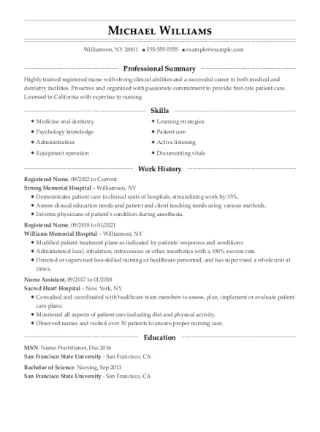Our customers have been hired by*:*Foot Note

How To Write A CV Sample
How to write an effective curriculum vitae
The curriculum vitae, also known as a CV, is a lengthy document that covers all aspects of your experience and education in the United States and Canada. Many people often treat the CV as an alternative to a resume, but it is another document entirely. On a curriculum vitae template you need to pay close attention to its structure and the content you should include. With this handy CV writing guide, you can construct the best CV for your next job search.
Build my CVWhat is a Curriculum Vitae?
The traditional CV is mainly used within academia to display your research prowess, educational background and other relevant professional experience. But a CV can be used in other industries too. CVs are diverse documents that can show off all your most notable accomplishments throughout your career. This includes your research projects, certifications, degrees and more.
A curriculum vitae differs from a resume in that it covers your work history, academic background and credentials in more detail. Potential employers might take a CV in other industries, but it’s usually best for competitive senior positions. Additionally, CVs can go past the usual one-page limit for a resume and be as long as three pages.
CV vs. Resume
The difference between a CV and a resume largely depends on where you’re from. In the EU, a CV and a resume are the same documents that are submitted to a potential employer detailing your work experience, certifications and skills to prove that you’re a good candidate for a job title.
What is the difference between a resume and a curriculum vitae in the U.S.? A resume is a document you submit to hiring managers to get a new job. A CV, on the other hand, is a lengthier document that thoroughly summarizes a person’s work history, detailing every relevant point in the person’s career, including their research experience. A resume is like a list of details about the job seeker, while a CV is more like an in-depth profile.
Another key difference between the two is that resumes are used in nearly every kind of job position and industry while CVs are primarily used for positions in academia. Job applications that benefit from having a CV include:
- Research assistant
- Lecturer
- University or college professor
- Assistant teacher
- Mentorship roles
- University dean
How to Write a CV With Sections
- Contact Information: Clear and correct contact information is needed from every applicant including your full name and phone number. You can also add your social media links, such as your LinkedIn profile.
- Objective Statement: In this section, give an overview of your top career highlights relevant to the position. Describe your professional or academic specializations, key skills or relevant attributes, and key achievements to show why you’re the ideal candidate.
- Summary of Qualifications: This section should be focused on what you can offer to a potential employer by highlighting what makes you unique. You can also highlight your affiliations with any professional bodies or groups. Think of these as lengthier descriptions of the most important attributes that would otherwise belong on your skills list.
- Core Qualifications/Key Skills: These sections represent technical or special skills that directly reference the terms used in the job description.
- Education: The education section should be presented in reverse-chronological order with your high school listed last. Keep your details brief here — you do not need to include your GPA.
- Work History: This section should be presented in reverse-chronological order, just as with a professional resume, and highlight your main achievements and professional skills. Remember to include quantifiable metrics to demonstrate precisely what you contributed to past employers.
- Awards: Academic and professional achievements you have received.
- Certifications: Credentials earned via training online, night classes etc.
- Publications: List research papers, articles or other published writing related to your work.
- Grants and Fellowships: List financial grants or admittance into fellowships. This shows potential employers that you’ve proven yourself to influential people in your field.
- Conferences: Professional and industry events you’ve participated in shows your commitment to taking a holistic interest in your industry through networking and learning from peers.
- Affiliations: Highlight major, industry-relevant associations you’re a part of or have worked with directly.
How to Write a CV
The CV contains multiple elements, all of which work together to convince a hiring manager to hire you for your dream job. If you’re having trouble, you can follow this CV structure to help you get started.
- Header
- Personal Statement
- Skills
- Work history
- Education
- Achievements and awards
Depending on the job title you’re after, you may also want to include sections related to any research you’ve published, as well as grants or fellowships you’ve received.
Header
The header should contain all your contact information at the very top and should include:
- Your full name
- Your phone number
- Your email address
- Your professional title
- Professional social media links, like your LinkedIn profile
Personal statement or resume objective
The personal statement of a CV has a similar function to a resume summary or resume objective. Essentially, a personal statement is a pitch of your entire career in just a few sentences. Make sure you cover the most relevant hard skills, work experience and research you’ve done in this section.
For example, if you’re applying for a role as an editor in a scientific research journal and you were once a research assistant, you’ll want to mention that in your personal statement. If it’s the most relevant work experience you have, then you’ll want that to be the first point a recruiter knows about you.
For job seekers with little work experience, a resume objective can be written instead and this should also be no more than three sentences. The resume objective is a personal statement highlighting the applicant’s goal and intentions for applying. For example, if you’re applying to be part of your first research project, explain why participating in the project is important to you and what you can bring to the table. You can also mention any professional affiliations that can advocate for you as a candidate.
Skills
In the skills section, list your hard skills and soft skills. Hard skills are technical abilities that you are trained for, such as being familiar with certain procedures or software. Soft skills display your work ethic and can include aspects such as creativity, time management, resourcefulness or conflict management.
Ideally, you’ll want to list between 8-12 relevant skills. Read the job description to find keywords related to the specific job so you can narrow down the list of skills that set you apart from other candidates.
Work experience
This section should be presented in reverse-chronological order, just as with a professional resume, and highlight your main achievements and professional skills. Remember to include quantifiable metrics to demonstrate precisely what you contributed to past employers.
Education
The education section of a CV is perhaps the most important section. As with your work experience, list your credentials in reverse-chronological order to display your most recent degree or accreditation first. Adding a master’s degree or even a doctorate at the top of the list can set you apart from other candidates. You also have more room to list your specific research projects, dissertations and other academic contributions here.
Awards, certifications and memberships
Awards and certifications can improve your chances of being selected for a job interview. They show that you have been recognized for your work, which in turn will make you seem like a more impressive candidate.
Memberships to specific academic organizations within your field of study are another plus. Specifically, memberships can show that you are already part of a larger community of researchers with similar studies and interests.
Build my CVModifying Your CV
Although CVs are different from resumes and include more sections, creating and formatting a CV that will pass ATS and impress hiring managers using our ResumeHelp Resume Builder is easy!
Follow these simple steps to build your CV:
- Click one of the “Create my CV” buttons. On the new page that appears, select “Create a new resume” to begin the process. Then select “Let’s get started” on the next page.
- Follow the steps on the page and fill in the blanks.
- First, choose one of our 17 resume templates, then select if you want to create a new resume or upload an existing document.
- The builder will automatically guide you through creating the summary and adding your work history, skills and education.
- After writing your summary, you’ll be able to add extra sections and begin customizing your document. Click the box on the top right to use the add sections feature and select “other” from the drop-down menu so you can title and fill in your own custom skills or certifications.
- When you reach the end of the builder, you’ll see your CV to move your new section or any of the preselected builder sections. Hover over the left side of the column you are trying to adjust and select the arrow icon pictured below.
- If you need to edit one of your sections (including your custom sections), select the three dots on the right and edit drop-down options will appear. This way, you can organize the layout of your CV accordingly.
- If you would like to change the headers of any of your CV sections, simply hover over where it says “Summary,” “Education,” etc., until the Rename button appears. Then put your new title in the space provided and click enter.
- You can change the formatting of your document on the menu at the bottom of the page. After clicking the arrow next to “Normal,” press the “Custom” button. A new menu will appear, where you can adjust the margins, font size, font style and spacing. If you want to change the color, a menu with different options will appear when you click the “Color” tab.
- Be sure to click “Spell Check” at the top left to ensure no grammatical errors.
- Once satisfied with your CV, click “Download” and save the document on your computer. If you don’t want to download it just yet, press “Save and Next” so your work isn’t lost.
Other CV Templates and Tips
Following a CV format is just one step to building the perfect CV. Here are a few other tips to follow when using a curriculum vitae template.
Write the best document for your needs with our builder
The best way to write the correct document for your personal needs, whether you’re looking for an internship fresh out of graduate school or you’re finding a prestigious professorial position, is to have the right tools. With templates, our Resume Builder and plenty of examples, it’s easier than you think to build a CV or a resume that will make it easier to apply for the job you’ve been searching for. Our library of resume samples can help make crafting the right document for your job search a breeze.
Important Points:
- A CV is a lengthy document that goes through all of your career and academic history. It is usually two to three pages long, but has no page limit, so it can potentially be 10+ pages long.
- A resume is a much shorter document — typically one page long or in cases where you have more than 10 years of experience, use a two-pager. It is much more focused on what is relevant to the position you are applying for.
- Both documents should be tailored to the position you’re applying for and the requirements of the job posting (this includes formatting too!).
Pay attention to small details
The adage “Don’t sweat the small stuff” definitely doesn’t apply to job applications. Every tiny aspect of a CV will be scrutinized. The hiring manager wants to find the best overall candidate.
Even fonts and specific word choices matter. Fancy or curly fonts are not meant for the applicant tracking system (ATS) because the software will be unable to read them. Stick to simpler fonts, such as Times New Roman, Calibri, Arial or Helvetica.
As to word choice, pulling keywords from the job description is a surefire way to push your application through to a hiring manager. The more keywords the ATS can detect, the better your chances are of being noticed.
Don’t forget the cover letter
Oftentimes, your CV presents a snapshot of your different career highlights and skills but not quite enough background to fully explore your most notable qualifications. That’s what the cover letter is for. It gives you the chance to explain why you believe your work experience makes you the best fit for a role.
You can use our Cover Letter Builder to find plenty of cover letter templates and examples that can help you get started.
FAQ: How to Write a CV
Have questions? We’re here to help.
How long should a professional CV be?
A standard CV includes the following sections: Contact Information, CV Profile, Work Experience, Education and Skills. Good additional sections to put on a CV are: Certifications, Associations, Languages, Extra Training and Courses, Conferences, Publications or Awards. Depending on your experiences and the position you are applying for your CV can be anywhere from 2-10 pages. For the employer to require a CV it means that they’re looking for specific supplementary information, but the same basic resume rules of most relevant information at the top and clear formatting still apply. Before your reasonably formatted 5-page CV lands on your future boss’s desk it still has to make it through the ATS and a hiring manager that can’t read 10+ page submission packages for every candidate.
How should a CV in 2024 be written?
The purpose of a CV is to show that you have the skills required for the job. Your selected CV sections should demonstrate you understand the employer’s objectives and are motivated to deliver them. Meaning that sections like your skills, core qualifications and personal statement should come first, and directly prove your interest and qualification for the role. You should also include a cover letter with a CV because it’s an important part of the application process. It allows you to go into even more detail about your background than a CV and helps you stand out by delivering a personalized letter about your goals and achievements. Check out our Cover Letter Builder to assist you in writing your documents.
What information should I include in my CV?
A very bare-bones CV is still customized to the requirements section and should include basic information like your contact information, education, research experience, teaching experience (if applicable), publications, presentations and references. Other potential categories are listed below and may include awards, professional affiliations, community or university service, and others. Supplementary sections could be required at the discretion of the hiring manager or company and could include things like relevant hobbies, sports and volunteer opportunities. Other countries or specific industries (like entertainment) may also require you to disclose information regarding your marital status, date of birth, appearance and ID or trade numbers you may be required to possess.
What is the best CV format?
Ideally, a CV at minimum is two pages long as you’ll be including supplementary information that wouldn’t be found in a normal resume. This means that since the document is customized to your specific career and educational experiences and to your specific employer’s requirements, there is no set format. You can still structure your CV in an effective and eye-catching way, though. With ResumeHelp’s examples you can frame your core qualifications like the skills sections in a combination resume, draw attention to your educational experiences like in a functional, and keep your work experiences, publications and research projects well organized and in reverse-chronological order like you would in a more traditional resume. Remember when formatting a CV it’s not just about the first impression, it’s showing off your employment history in a way that currates your best professional experiences and key responsibilities. If you’re having trouble deciding how to structure your experience section or what to leave off, then take a look at some CV examples to understand what you need to focus on.
Couldn't find the answer you're looking for?





